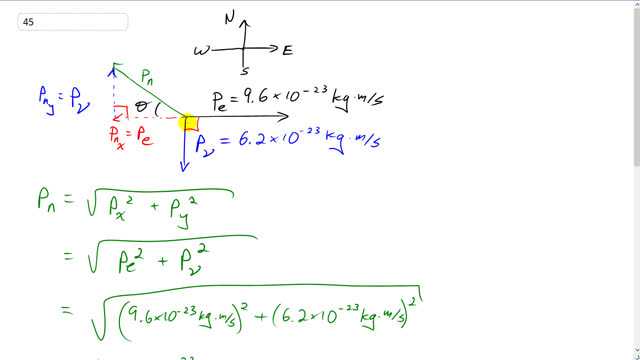
A radioactive nucleus at rest decays into a second nucleus, an electron, and a neutrino. The electron and neutrino are emitted at right angles and have momenta of and , respectively. Determine the magnitude and the direction of the momentum of the second (recoiling) nucleus.

In order to watch this solution you need to have a subscription.
This is Giancoli Answers with Mr. Dychko. This radioactive nucleus, which is initially at rest, decays into three parts that explodes into an electron going one way, a neutrino going at 90 degrees a different way and then the remaining part of the nucleus has to go in this direction and we know that because it has to have an x-component of its momentum equal to the x-component of the electron's momentum. And this nucleus has to have a y-component to its momentum equal to the neutrino's momentum so that the total momentum of all three parts adds up to zero. Now when I see equal, I mean equal in the opposite direction so one is the negative of the other. So this momentum of the nucleus x-component is gonna be the negative of the momentum of the electron. So I have set up the coordinate system this way where the electron and neutrino are at 90 degrees because we are told that by the question and then defining the electron to be east and the neutrino to be south, why not, and that makes it easier for us to express our answer; we are gonna say, you know, the nucleus has an angle such and such 33 degrees north of west. We could have also given the angle with respect to one of the other particle's momenta, you know, doesn't really matter but as long as it makes sense and it's not ambiguous. So the magnitude of the nucleus's momentum is gonna be this is the resultant of these two components and since the electron and neutrino are at 90 degrees, the components of this nucleus's momentum is conveniently gonna be equal to the momentum of the electron for x and the momentum of the neutrino for the nucleus y-component and that means we take the square root of the sum of the squares of the electron and the neutrino momenta to get the momentum of the nucleus, magnitude anyway. So nucleus is gonna have a momentum of 9.6 times 10 to the minus 23 kilograms meters per second squared and then—sorry about that, it's in here somewhere— I'm getting second function entry, there it is. So square root of 9.6 times 10 to the negative 23 kilograms meters per second, square that plus the momentum of the nucleus squared square root it all, you get 1.1 times 10 to the minus 22 kilograms meters per second. And then for the angle Θ, we have to take the y-component of the momentum divided by the x-component of the momentum for this nucleus and then take the inverse tangent of that to get Θ n—Θ for the nucleus. So that's inverse tangent of 6.2 times 10 to the minus 23 divided by 9.6 times 10 to the minus 23 kilograms meters per second and that gives 33 degrees that's north of west and there's our answer. Momentum of the nucleus, 1.1 times 10 to the minus 22 kilogram meters per second, 33 degrees north of west.
A radioactive nucleus at rest decays into a second nucleus, an electron, and a neutrino. The electron and neutrino are emitted at right angles and have momenta of Pe = 8.99×10−23 kg⋅m/s and Pν = 6.10×10−23 kg⋅m/s , respectively. (Figure 1)
For part A) 3 sig figs: I got 1.09x10^-22 kg * m/s RIGHT
For part B) 3 sig figs: I got 34.2 degrees, WRONG
I did not have to chose or type in the units so that can not be the issue
Not sure why B is wrong???